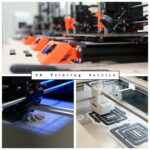Projet IODA : Article – Solvent-free extrusion of a LiFePO4-based monofilament for three-dimensional printing of a lithium-ion battery positive electrode
January 5, 2024Read the full publication : sciencedirect.com/science/article/abs/pii/S0378775323013496
More on project IODA : nanovia.tech/en/project-ioda-3d-printing-lithium-ion-accumulators/
Abstract :
Tags: Project IODATo meet the final objective of 3D printing a high-performance liquid-electrolyte lithium-ion battery using Fused Filament Fabrication (FFF), a positive electrode filament formulation based on LiFePO4 and carbon nanofibers (CNF) is, herein, in-depth investigated. A highly-loaded composite monofilament containing a co-continuous structure of an immiscible non-polar (polypropylene-PP) and polar (polycaprolactone-PCL) thermoplastic polymers blend is successfully produced by hot-melt extrusion. This specific formulation confers desirable properties to the 3D printed electrode such as a mechanical integrity during cycling and good affinity with the electrolyte. Furthermore, for up-scale purpose, the incorporation of an optimal amount of thermoplastic elastomers (TPE) into the filament composite to gain in flexibility is examined and its ability to be rolled around a spool at the extruder exit is modelled on the basis of experimental values of mechanical properties. In addition, it is shown that the larger-scale extruded filament has better electronic properties and the corresponding 3D-printed electrode exhibits excellent electrochemical behavior, making it possible to envisage an industrial scale-up production.


